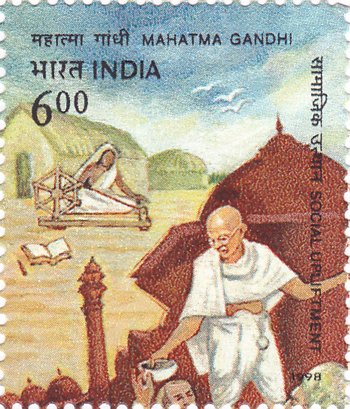Mahatma Gandhi – Social Upliftment (50th Death anniversary)

Technical Data
| Stamp Set | Death Centenary Golden Jubliees Mahatma Gandhi Memorial |
|---|---|
| Date of Issue | January 30, 1998 |
| Denomination | Rs. 6 |
| Quantity | 700,000 |
| Perforation | comb 14 |
| Printer | Security Printing Press, Nashik |
| Watermark | No Watermark |
| Colors | Multicolor |
| Catalog Codes |
Michel IN 1612 Stamp Number IN 1672 Yvert et Tellier IN 1379 Stanley Gibbons IN 1776 |
| Themes | Anniversaries and Jubilees | Famous people | Human Rights | Independency Activists | Lawyers-Advocates | Men | Optical Instruments | Teachers |
Table of Contents
Commemorative Stamp: Mahatma Gandhi – Social Upliftment (50th Death Anniversary)
Design Elements:
- Central Imagery: The stamp features Mahatma Gandhi engaged in activities related to rural development, social reform, and upliftment. Gandhi is depicted sitting among villagers, spinning a charkha (spinning wheel), which symbolizes self-reliance and economic empowerment.
- Background Elements: A rural Indian village scene in the background, with mud huts, open fields, and women and children participating in daily activities, representing the heart of Gandhi’s focus on village upliftment.
- Color Palette: Earthy tones dominate, with shades of brown, green, and white, reflecting the simplicity and purity of rural life that Gandhi cherished.
- Symbolic Objects: The charkha, a symbol of self-reliance and resistance against colonial economic policies, is prominently featured.
Cultural and Historical Significance:
- Focus on Rural India: Gandhi believed that India’s soul resided in its villages. His efforts towards the upliftment of the rural population were central to his vision of a free and self-sustaining India.
- Promotion of Khadi: The charkha on the stamp is a reminder of Gandhi’s khadi movement, which encouraged the use of hand-spun cloth as a symbol of resistance against British industrial goods.
- Gandhi’s Vision for Swaraj: The stamp symbolizes Gandhi’s belief that true freedom (Swaraj) could only be achieved when the villages were self-reliant and free from poverty.
Usage:
- Commemorative Purpose: This stamp commemorates the 50th anniversary of Gandhi’s martyrdom, focusing on his efforts for social and economic upliftment.
- Educational Tool: The stamp serves as an educational reminder of Gandhi’s dedication to improving the lives of the rural poor and his efforts to create a self-sufficient Indian society.
- Philatelic Collectible: It is a valuable item for collectors, symbolizing an important aspect of Gandhi’s multifaceted contributions to India’s freedom and social reform.
Importance of the Commemorative Stamp:
- National Tribute: The stamp honors Gandhi’s commitment to social justice and his relentless work for the upliftment of the marginalized and oppressed sections of society.
- Promotion of Self-Reliance: It reinforces the importance of self-reliance and the role of grassroots development in achieving national progress, as envisioned by Gandhi.
- Cultural Reflection: The stamp is a cultural reflection of India’s rural heritage and the ongoing relevance of Gandhi’s teachings in modern times.
Example of the Stamp Design:
- Primary Focus: Gandhi spinning the charkha, surrounded by villagers, with the background showing a simple, serene village setting.
- Text: The stamp includes the words “Mahatma Gandhi – Social Upliftment” and “50th Death Anniversary” along with the year of issuance.
Significance:
- Honoring Gandhi’s Legacy: The stamp highlights Gandhi’s lifelong dedication to the cause of social upliftment and his efforts to ensure that freedom reached the poorest of the poor.
- Educational Value: It serves as a tool to educate people about Gandhi’s social reforms and his vision for a self-reliant and equitable society.
- Inspiration for Future Generations: The stamp continues to inspire future generations to work towards social justice, equality, and the upliftment of the underprivileged, following the principles laid down by Gandhi.
